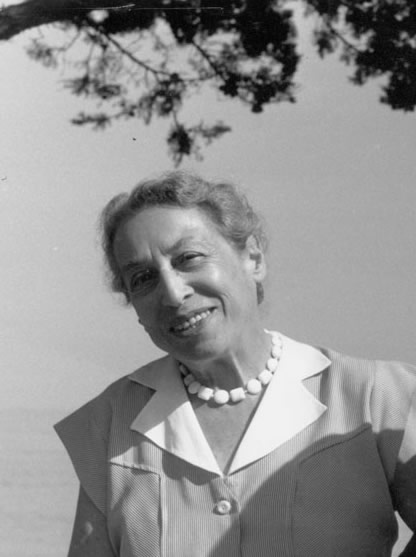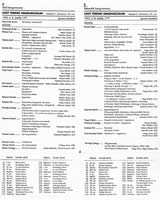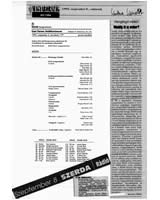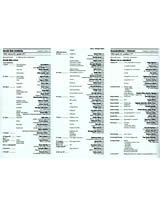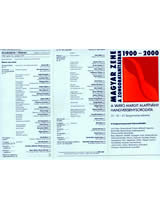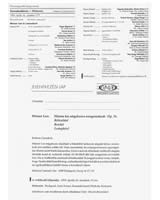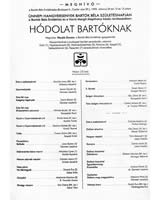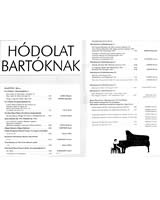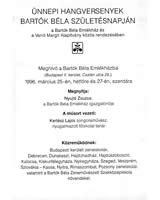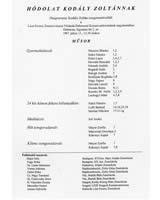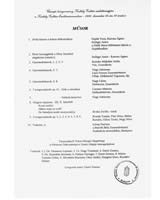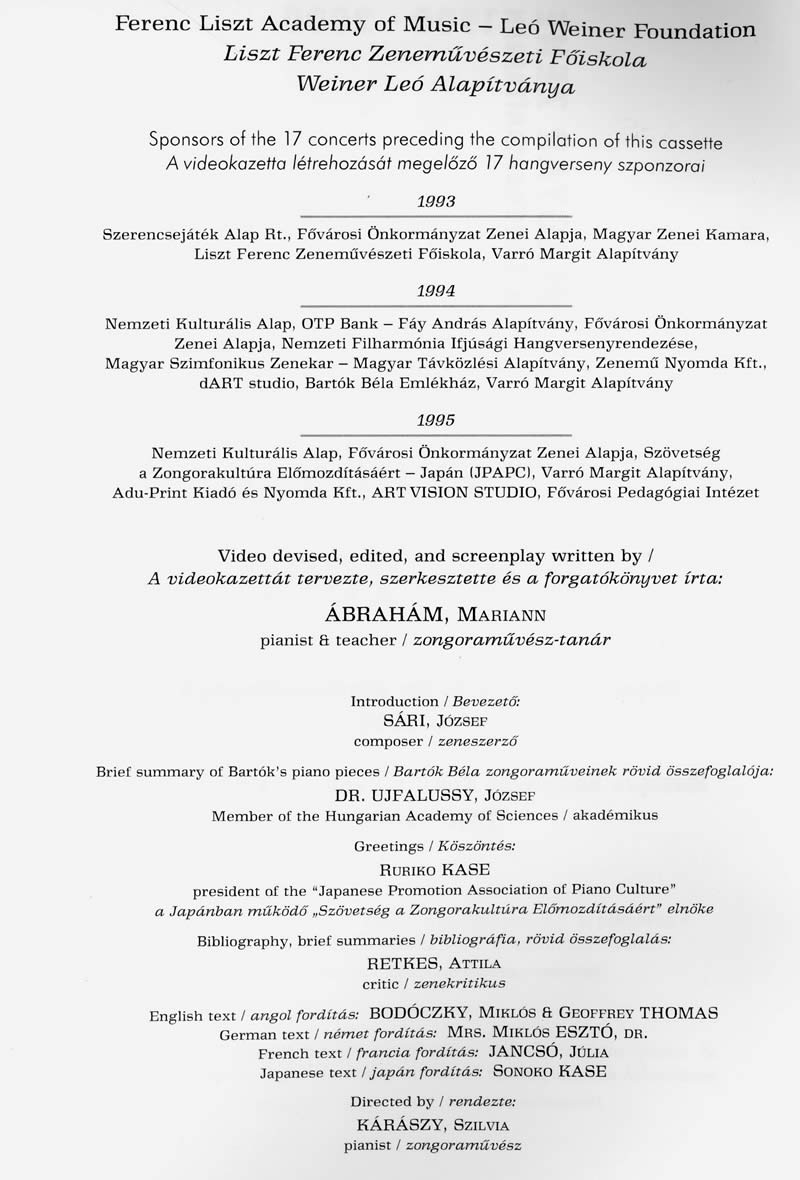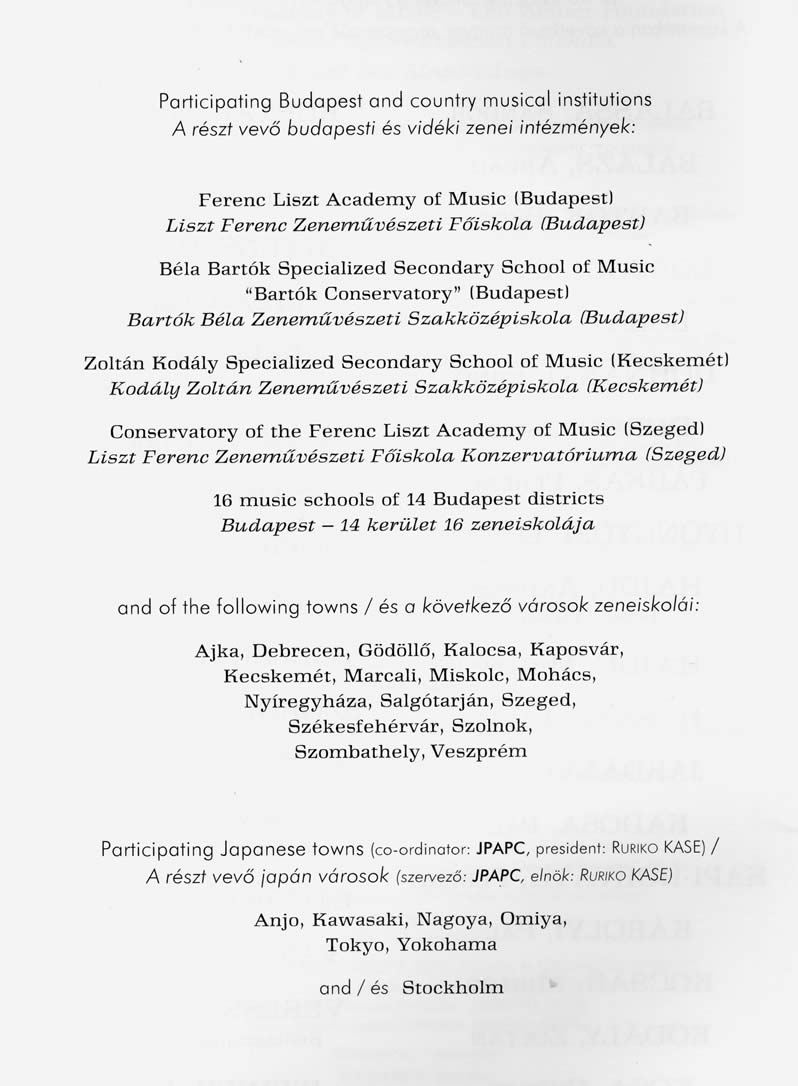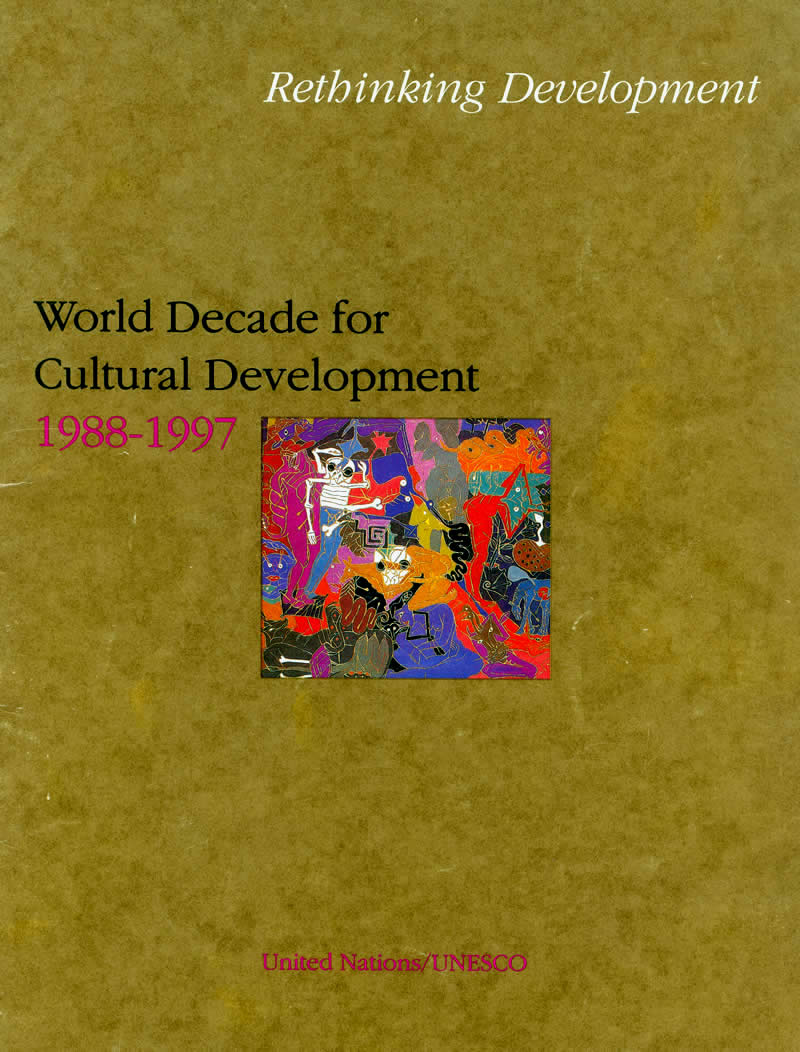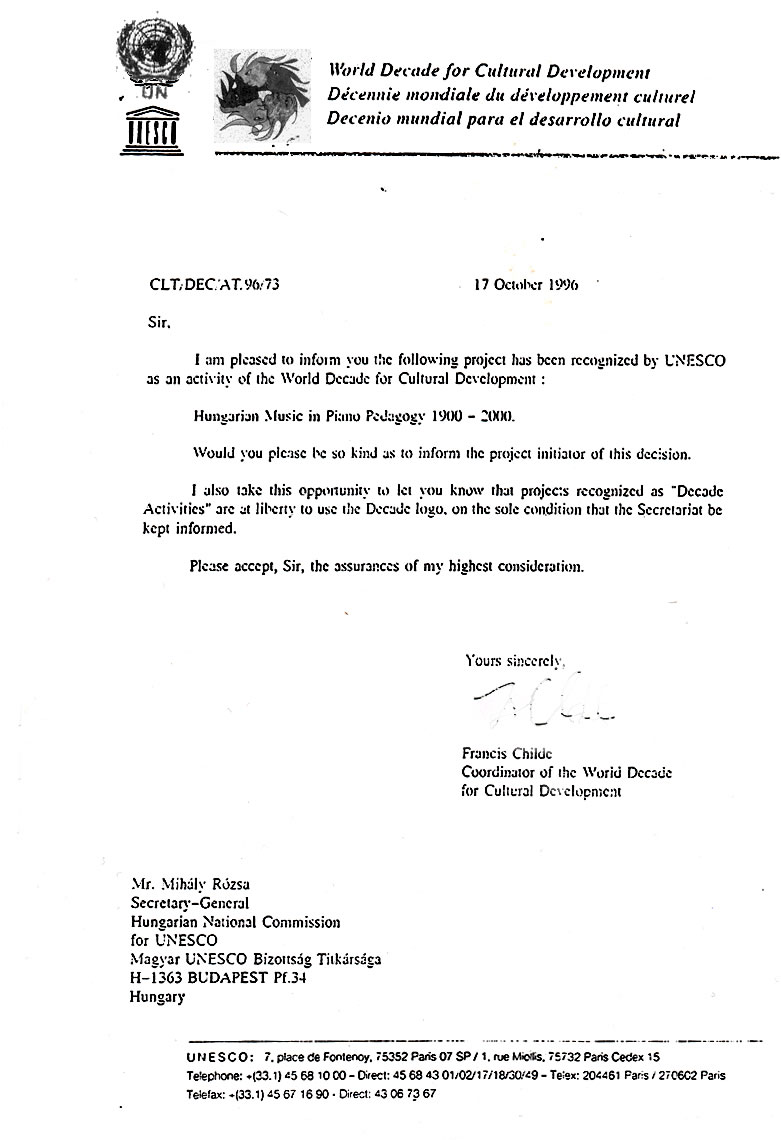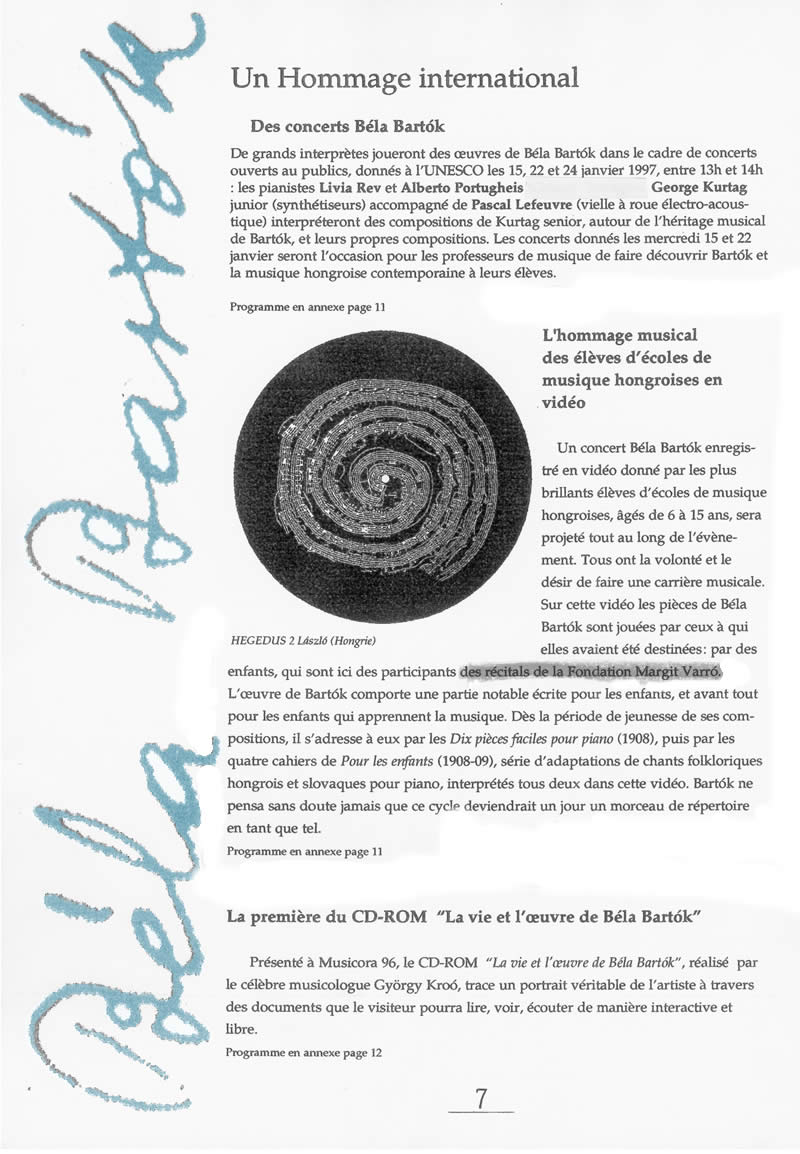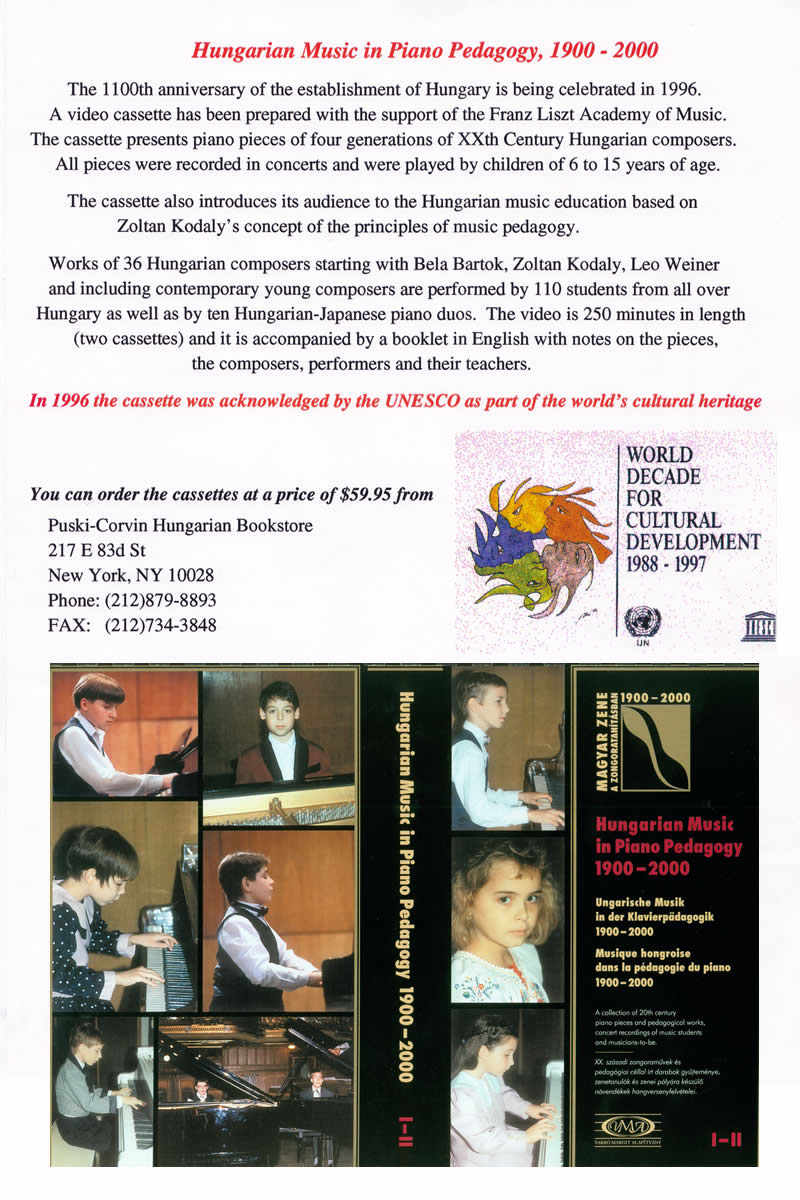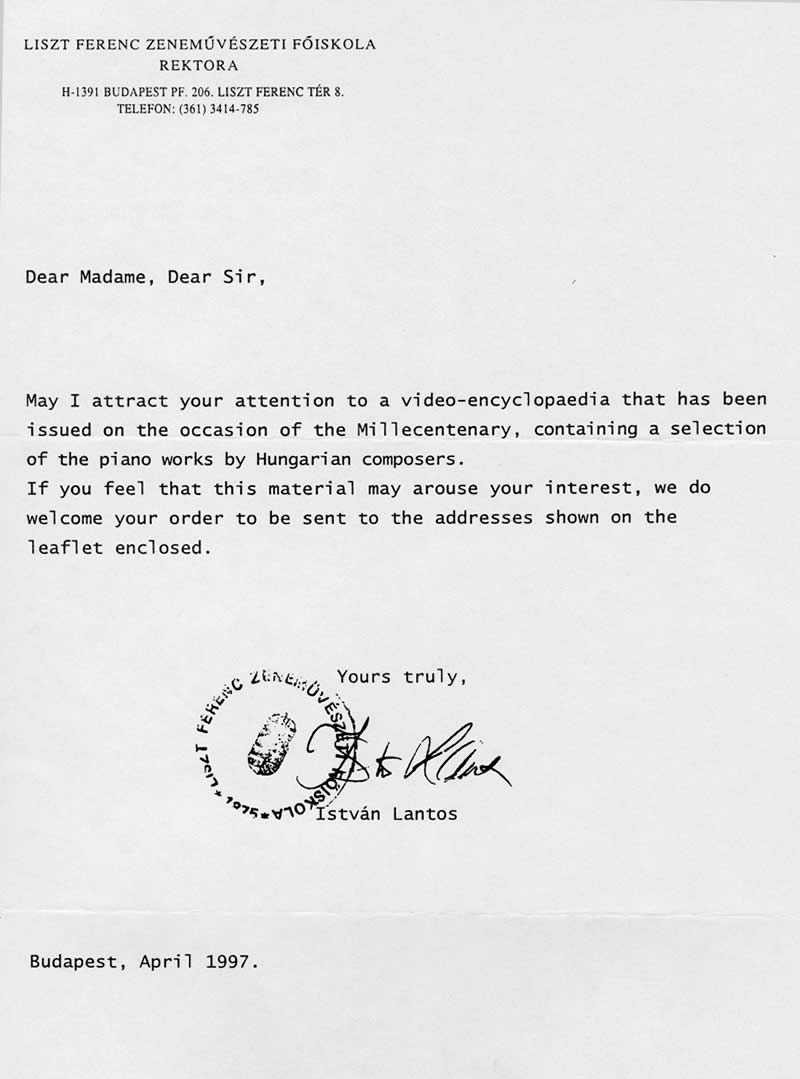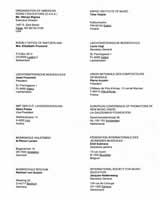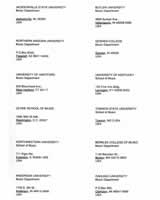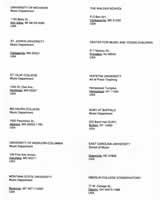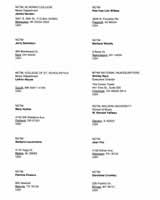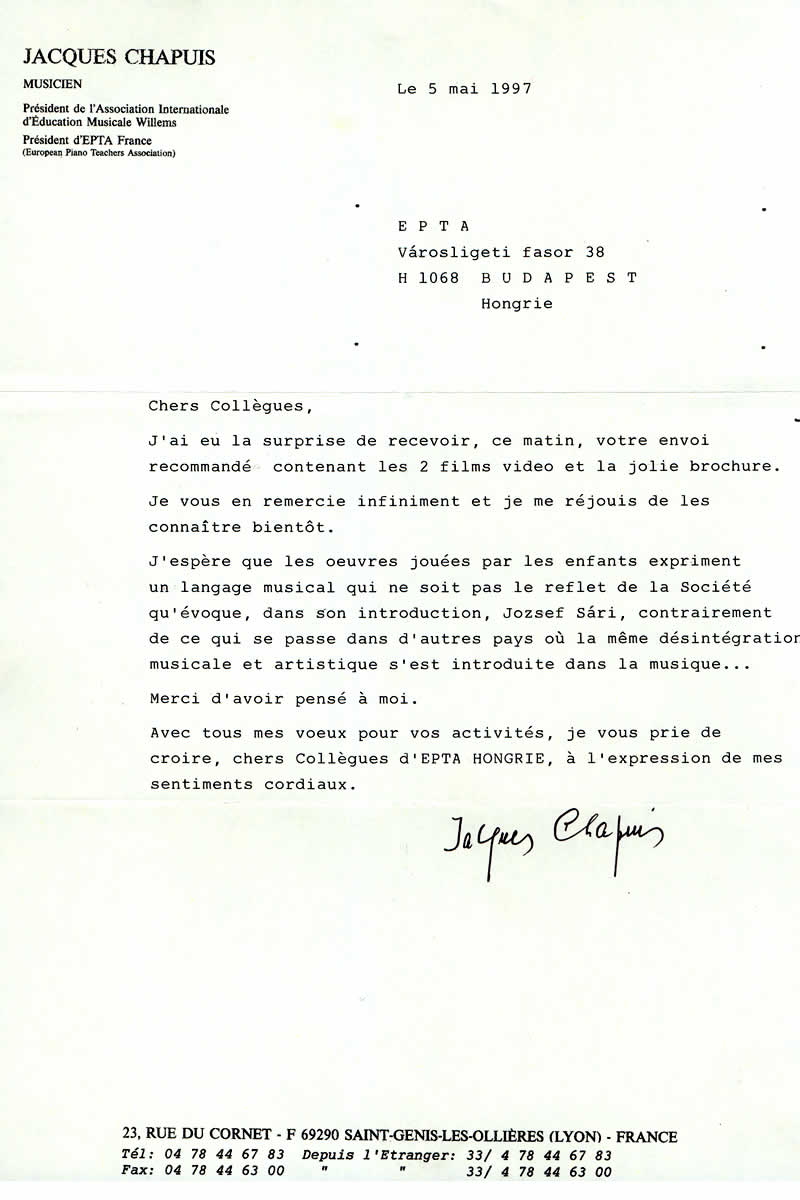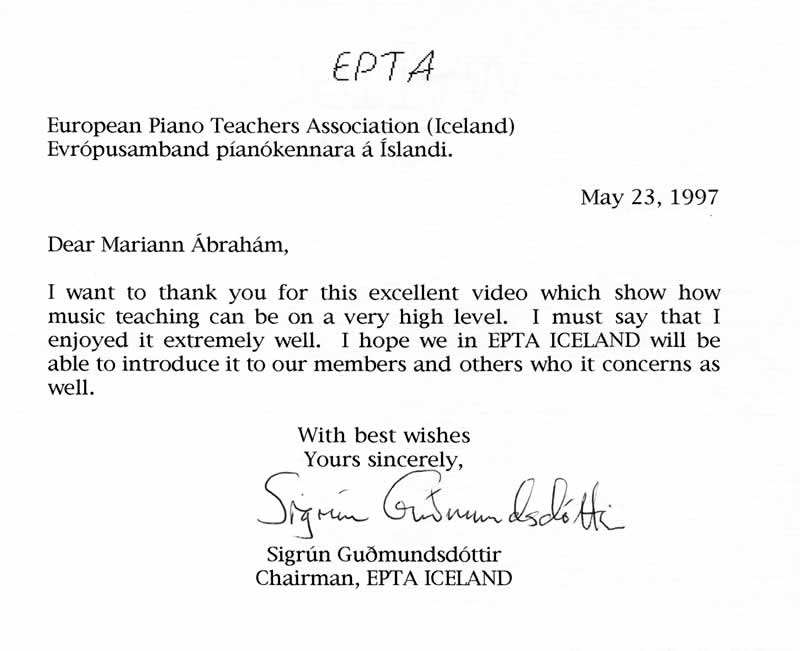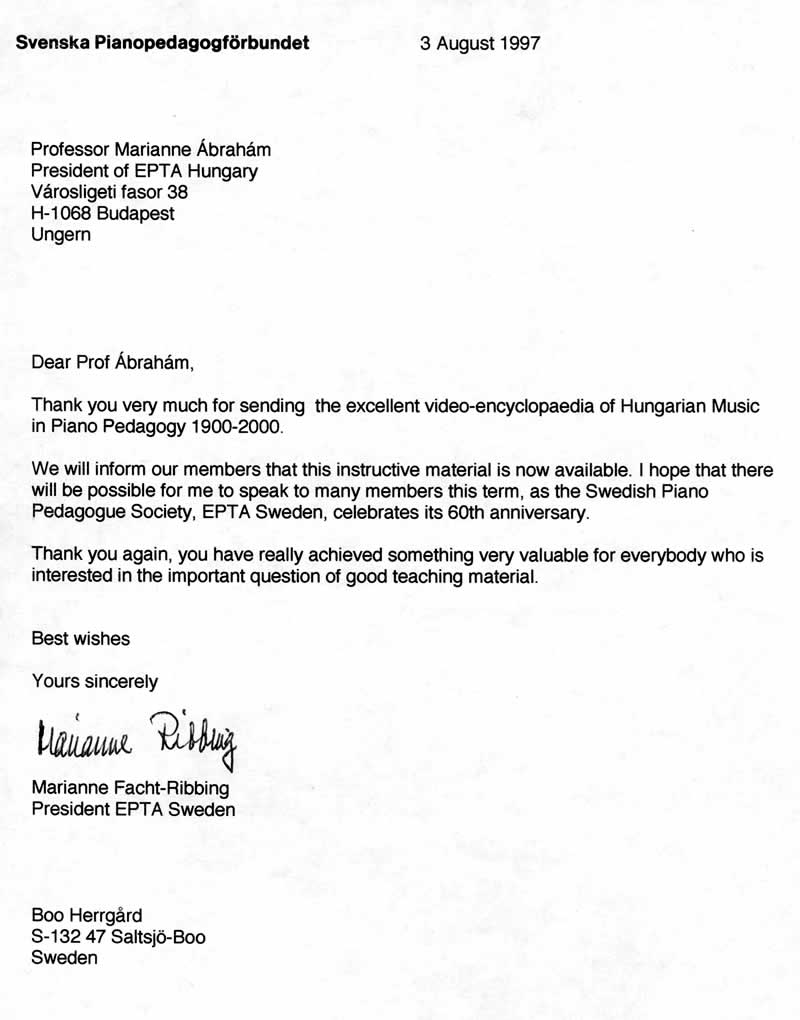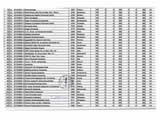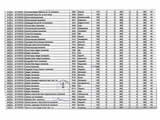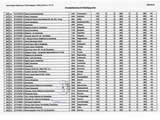Margit Varro
Foundation
(founded by: Mariann Abraham)
(1992 - )
Margit Varro 1881 - 1978
__
___________________
______
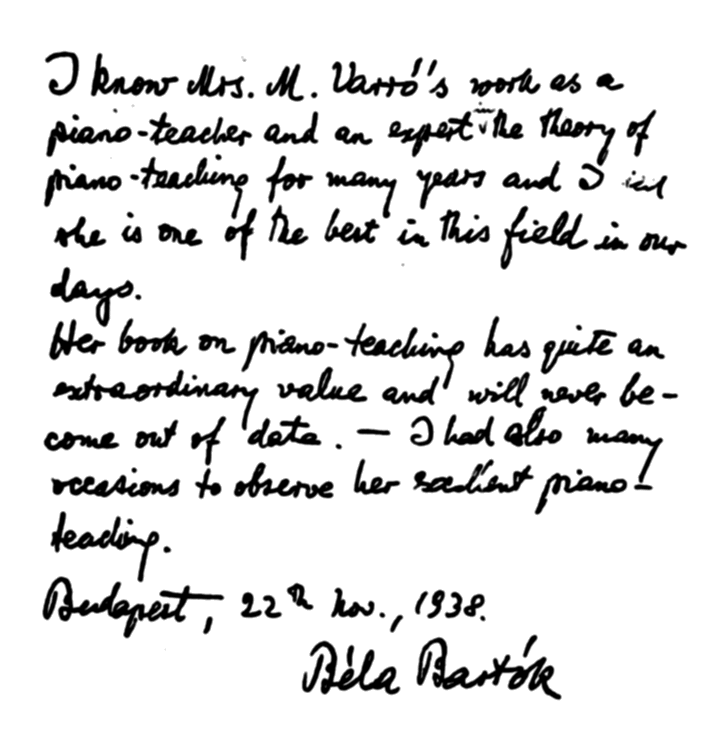
__
___________________
______
GROVE MUSIC LEXICON
(OXFORD UNIVERSITY PRESS revised version, 2013)
Varró [née Picker], Margit
(b. Barcs, 22 October 1881; d. Chicago, 15 May 1978). Hungarian piano teacher. Initially self-taught, she studied with one of Liszt’s last students Árpád Szendy at the Hungarian Royal Academy of Music graduating in 1907. After consolidating her teaching experience at the Ernő Fodor School of Music (1907-8), she began to give concerts and develop her own private teaching practice. For a short period (from 1918 -1920) she taught methodology of piano teaching at the Hungarian Royal Academy of Music; appointed on 15 February 1919 she was the first female instrumental teacher to get an appointment. Thereafter she concentrated on her private teaching practice. Her detailed, systematic observations on piano teaching, music psychology and performance form the basis of her first book, Zongoratanítás és zenei nevelés (1921). Revised and expanded the book appeared in German in 1929, and it immediately established her reputation as an outstanding teacher well beyond Hungary, and attracted invitations to give lectures, courses and broadcasts throughout Europe. In 1938 she was invited by MTNA (Music Teachers National Association) to several Universities in the US (where she arrived on 20 October 1938). Because of the war she could not return to Europe. In the US she continued teaching, writing, lecturing. She is considered to be a pioneer of the ’auditive approach’ to piano teaching, and in the area of teacher-pupil relationships based on psychological observation and experimentation.
Between 1939-59 in Chicago Margit Varro taught in the following institutions: Sherwood Music School, Institute of Design- Illinois Institute of Technology, Musical College of Roosevelt University. During this period she was active as a private teacher too until the age of 95.
Writings
Zongoratanítás és zenei nevelés [Piano Teaching and Music Education] (Rózsavölgyi, Budapest, 1921;) (Hungarian edition of the revised and extended version: Editio Musica Budapest, 1989)
Grundlagen des Musikunterrichts / Foundations of Music Pedagogy (I.II., Allgemeine Musik Zeitung, Berlin, 1926, June-July)
Der lebendige Klavierunterricht: seine Methodik und Psychologie, (1929, Simrock, Berlin-Leipzig). Further publications: 1930, 1951, 1958, 1998. French translation and publication of ’Der lebendige Klavierunterricht’: 2008
Designs to Music (Apprentice House, Chicago, 1952)
The History of Music, TV series commissioned by UNESCO (1957)
Tanulmányok, előadások, visszaemlékezések [Studies, lectures, memories] (Editio Musica Budapest, 1980)
ed. M. Ábrahám: Két világrész tanára/A Teacher in Two Worlds (Zenemű Nyomda, Budapest, 1991)
Dynamic Piano Teaching (Simrock, Elite-edition, London-Hamburg, 1997)
[previously published in: Két világrész tanára/A Teacher in Two Worlds, 466-520]
ed. M. Ábrahám: Varró Margit és a XXI. század/Margit Varró and the 21. Century (Győri Nyomda, 2000)
Bibliography
V. Lampert: On the Origins of Bartók’s Mikrokosmos, (Studia Musicologica, 39/1 (1998), 123-137)
Foundation
by M. Ábrahám: Margit Varró Foundation, March 1992, Budapest [Registration number: 9. Pk. 67291/3, 2849]. From 2003: run by Municipal School of Music at Fót.
The Principles in Margit Varro's
Musical Education
- biographical data, bibliography -
written by
Mariann Abraham
Little is known
about Margit Varro's musical studies (Margit Picker, married to Dr. Istvan
Varro, born October 22 1881[1], died
May 17, 1978). The student newspaper[2] of an
American musical institution made an interview with her. Here she introduces
herself to her students as follows:
"Ever since I can remember I have been playing the piano: I had played four-hands, Hungarian pieces before I was 6. I read notes long before reading books.
I was ten when my parents sent me to Austria to study at an institution where I was given my first piano lessons. But what piano lessons these were! At the beginning of the lesson I had to prepare my teacher's medicine, then I had to play scales while my teacher fell asleep. After 50 minutes he woke up and gave me the homework for the following week. It was a great disappointment I almost broke under it. If I had been less independent, I would not have gone on with studying music. I have always thought that a piano lesson is something wonderful, that is why it was so disillusioning.
Luckily I was soon sent away to another teacher, who was not any better than the other from the pedagogical point of view, still he gave me more. This teacher made me play nothing but four-hands, classical and romantic transcriptions, symphonies, overtures, chamber-music. This had only one advantage: I got better acquainted with the orchestral and chamber music-literature. Otherwise I could not have the opportunity to do so. Nowadays you can learn about new pieces while listening to the radio or playing a record but back then - and it was not so long ago- this was unheard of.
Somewhat later, when I was admitted to the Orszagos Magyar Kiralyi Zeneakademia[3] (National Hungarian Royal Academy of Music) in Budapest, I got under the guidance of a former student of Liszt. He adored Liszt and took umbrage at my playing anything by Brahms. At the Academy I studied orchestration and composing. Although I've written some piano pieces, I could see that I was unable to come up with anything new, so I quitted this activity and limited myself to writing small pieces for my students.
I got into an awkward situation during my studies. Most the time it is the teacher who is dissatisfied with his or her student. In my case this was just the other way around: I was dissatisfied with my teachers. Any time I chose another teacher I hoped that she/he would bring out more of me that the former one. I felt that I was able to do more, and I was eager to prove it eagerly. However, only my last teacher could really influence me.
Counting in my former teachers, it is fair to say that for all practical purposes
I am an autodidact. Later on I learned a lot from observing what was going on the stage. It was there where I could see and hear what has to be done and how to achieve it. I was listening carefully, enjoying the performance very much, but for quite a while I felt only instinctively how it is done. At home I tried to get the same tones out of my own instrument. My subconscious remembered those tones, but it took a long time to get beyond the mere emotional impressions and by observing the technical aspects of playing to learn how to do it, something I had not known before.
- Also, you authored many books and articles.
- Yes, I speak five languages, so it has never caused me any difficulties."
Margit Varro's outstanding talent soon was drawn attention to. She got her teacher's degree with highest honours at the Academy of Music in the 1906/7 academic year. The National Hungarian Royal Music Teacher Licensing Committee awarded her with a pedagogical scholarship[4]. It was the first time this award has been announced. After winning it, she taught in the Fodor Music School for two years as a trainee[5] then she became a private teacher and started giving concerts ( in Hungary, Austria, and Germany)[6].
She got her nomination at the National Hungarian Academy of Music in the academic year of 1918/19. (Erno Dohnanyi was nominated to be the senior director and Zoltan Kodaly to be the vice director in the same year). She was in charge of guiding the teaching practices of future piano teachers. She was the first female instructor teaching instruments at the Academy of Music[7].
From the very beginning her pedagogical activity is hallmarked by articles on teaching, nurishing talent and by writings popularizing musical history and contemporary music ( Rachmaninov, Stravinsky, Bartok, Dohnanyi, Weiner)[8].
She summarized her practical and psychological observations her first book, Zongoratanitas es zenei neveles (Teaching Piano and Musical Education), published in 1921 by Rozsavolgyi and Co. She divides her book into two main parts: in the first she reveals her methodology, in the second she describes its application. Although it had a very good press, the book never became a widely used practical manual, as its revolutionary innovations in teaching music were against the contemporary principles[9].
Starting 1921 she became a private teacher again. Her field of interest is widening: she observes everything while teaching and records her experiences. The performances of the talents grown up under her guidance at the Music Academy are followed by particular deference in the daily, weekly and monthly papers by the most outstanding music critics: Sandor Jemnitz, Gyorgy Kerenyi, Antal Molnar, Aladar Toth[10].
Preceeding the second, enlarged edition of her book in 1926 she publishes her article Grundlagen des Musikunterrichtes (The Basics of Teaching Music)[11] where she once again emphasizes her main points with respect to piano pedagogy.
"a.)... teaching piano means first and foremost teaching music: the teaching of technical skills should go hand in hand with developing good hearing and the musical intellect... Before anything else we have to improve the student's sense for music... We shall try to make the student percieve the notes as symbols expressing musical thoughts rather than just a sequence of sounds. In the first weeks we should teach only by ear with nursery rhymes and the folk-songs as the basic tools..."[12]
The piano teaching based upon developing the hearing is not a new idea: Fr. Wieck[13] and L. Ramann[14] also thought of that as important. However, the practical tools, the instrumental-pianistic means and especially the appropriate learning techniques needed for its implementation had not been layed out clearly and systematically from a methodological point of view either. This work has been done by Margit Varro'. The Handbuch des Musikunterrichtes (The Manual of Music Teaching)[15] when reviewing the teaching of instruments based upon the development of hearing considers her work as pioneering in this field.
"...It is especially important that the musical skills and pianistic techniques of the students be impoved in parallel and in a unified way, because if we let the motorically skilfull child proceed too quickly, his/her style may become insipid and empty..., while if - on the contrary - we develop the talented child's hearing to the detriment of his/her skills, the contradiction between the overmature intellect and the insufficient skills can discourage and disappoint the student from learning music..."
"b.)....The natural inclination of children is to realize all the notions sensibly, visually, personifying them. We can take advantage of this in pedagogy when teaching music... The notions gained through musical introspection, though, have to be explained, made perfectly clear and systematic from time to time..."
Zoltan Kodaly claims the same principles in general music education as the ones laid down by Margit Varro in the context of teaching instruments[16].
"... We should always systematize the notions with the active contribution of the child - with the help of questions, oppositions, comparisons, directing his or her own thoughts so that it would lead him/her to correct and exact articulation (method of Socrat)"
- says Margit Varro in her book Grundlagen des Musikunterrichtes.
Her book is even more valuable because she guides us on the way of children's thinking using many seemingly naive examples. This is why her teaching is full of life, this is what makes it as up-to-date even today, as it used to be decades ago. It makes us understand how wide a circle we have to start from in order to get to an already settled, crystallized, "living" notion that the child can understand.
c.) "...Above all, the goal of teaching music is to first educate the student to be a sophisticated listener of good music and later the expert performer of them at an early age, as all musicians once were listening and enjoying music before becoming creators of it..."[17]
d) Margit Varro makes improvization part of teaching music, proving its importance with many examples. In her view one of the most important tasks of teaching is to keep the child's playful instincts alive:
"... This instinct is his first schoolmaster, dominating his entire life... To repress it means to act against nature...."[18]
When elaborating on the question how to make the learning technique more economical Ms. Varro puts high priority on teaching how to increase the attention span and make it more intense. Her advice is to teach beginners in group lessons.
"... Group lessons (3-4 children at a time for about one and a half hour) have many advantages over individual teaching: it tires children less if their attention is divided between their own and their mates' instrumental playing, and between listening excercises fulfilled together.. the competitive atmosphere enhances their ambition to work, the common interest encourages the interest towards the topic, too. They learn to compare their performances, their playing with their mates', they get used to criticising, furthermore to being able to endure criticism... In the first academic year the lack of natural musicality of a student can still be compensated with a certain intelligence, skilfullness, and willpower. Often these children show as much progress in the beginning as their more gifted peers. After two or three years, however, individual talents become dominant, requiring individual, personalised treatment, and a this point group lessons have to be replaced by individual teaching...."[19]
The rearranged, German version of her book, Der lebendige Klavierunterricht was published by Simrock Co., Leipzig, in 1929. The first edition was followed by three more[20]. The book made Varro a household name in Europe.
".... It attracted international attention in music-pedagogical circles: only half a year after it has been published it was introduced as a mandatory textbook at the two most outstanding German music colleges, the conservatorie in Leipzig and the Klindworth-Scharwenka conservatorie in Berlin."[21] "... It is a great cultural success for Hungary that in the homeland of music where music-pedagogical works are overabundant, German professors offer the work of a Hungarian author to be the guiding line for their own teachers and institutions..."[22]
The book became widely known, a point splendidly proven by the fact that the publisher could choose from more that 50 critical reviews to promote the book before the second and third editions.
Bartok called the Der lebendige Klavierunterricht"an absolutely remarkable" book which will "never become obsolete"[23]. He had words of praise about Margit Varro herself, too:
".... I found very useful [...] the critical remarks of Margit Varro concerning my old piano school that drew so many attacks when it has been published. I had a copy of my piano school with Mrs Varro's remarks written on the margins: some pieces of the Microcosmos were composed with her remarks in mind."[24]
The chapter titled The Methodology of Teaching Beginners explains step by step how certain pieces of the Microcosmos outline the direction in which to proceed in order to establish the gradual and interrelated improvement of both the musical sensibility and consciousness and the playing techniques.
Der lebendige Klavierunterricht was a great success among psychologyists as well:
"... For a psychologist the first chapter of the book - discussing musical hearing and its development - offers a lot of interesting data. The way she is discussing how to treat students who's technique got spoiled and how should they practice is completely in line with the methodology of psychological sciences... Still the most important and most original part of the book turns out to be the third chapter, the psychological discussions. The author makes several methodological, pedagogical, even therapeutic points and suggestions, all based upon observation and experience, and she does it in such a clear, transparent and meticulously logical way that I have never seen in any treatise of musical pedagogy before. In this respect it not only displays a vast amount of knowledge that is almost unheard of but it is of fundamental importance and will never become obsolete."[25]
Margit Varro formulated already at the beginning of the century all those guiding principles that are considered to be modern even today: group lessons for the beginners, playing, singing, improving the musical ear, creativity, improvisation, group-dynamics etc.
Once the book has been published people came to study with her from all over Europe and even from overseas.
She gave lectures and led courses in Hungary and abroad.[26]
We find her name among the jury-members at the First International Liszt Piano Competition held in 1933.
She gave a lecture titled Musical Talent and Personality at the International Music Education Association in Prague in 1937.[27]
This is an outstanding year in her career. End of June as an invited speaker she is the one to represent Hungary at the International Conference on Music Teaching in Paris. Her topic is: The Child Listening to Music - how the Musical Experience Develops. On her way back she gives a talk in Basel under the title The Musical Talent, then she lectures in Milano and Brussels. Her lectures are published and praised in music journals.[28]
The discussions in the Paris conference were focussed around the juvenile concerts. One of the speakers was Walter Damrosch "... who was a pioneer of the musical culture in America... Initially his radio-shows... drew an audience of about one and a half million, but - 47 years later - 6 million children were listening to it every week. ...Robert Mayer started a similar movement in Great Britain. At the beginning he organised only a few juvenile concerts, but 15 years later they held concerts like these in 26 English cities..." From the Swiss report she learned that "they have held juvenile concerts since 1925 in several towns with free contribution of the best artists'..."
Once she returned home she wrote a report on the proceedings of the conference and she summarized it as follows: "we, who have given so many wonderful artists to the world, will not fall behind other nations concerning the education of the music-loving youth."[29]
Although she was primarily interested in individual musical education, she introduced the first concert of the newly organised "Small Filharmony" children-concert project[30]. After the concert she wrote: "... as far as I know this was the first true children concert that took the receptivity of the children into consideration and gave them an opportunity to join in (Canon singing!). Members of the "Small Filharmony" are young music teachers. As it is customary abroad, at the end we asked questions from the children: What did you like the most? - What would you like to listen to once again? - Do you play any instruments?" - In fact, this was the first organised juvenile concert.[31]
The chairman of the International Conference of Paris was Roger Ducasse. To prove the success and recognition of Margit Varro's lecture stands the fact that she was one of those three participants of the conference invited to sign the Golden Book of Paris, the " Livre d'Or de la Cite de Paris" ( 1938).
Ducasse spoke about Der lebendige Klavierunterricht with highest appreciation as well:
" After the first part about teaching and music esthetics... we get to the technique of modern piano-playing. We find everything here, recorded and analized with mathematical precision. The chapter on motorics is followed by the most important - and the most interesting - part, the psychological one. Just reading the contents of the chapters that follow leaves me not only surprised but full of admiration. As Athene follows Thelemakhos, observing all his smallest movements, guiding his acts, the teacher has to follow the student's emotions: to enhance them or let them evolve freely, to steer them in a direction that was chosen by the student himself, until he reaches the point that should be the ultimate goal of every teacher who is faithful to his profession: a mental state when the student consciously recognizes his/her own ambitions and the ways to fulfill them... The ultimate result of this kind of teaching is that the ideal of the classical thinkers - the self-perfection of man - is reached. It makes use of all the hidden skills and energy of the spirit and soul, it enables us to express our feelings in a healthy way, it teaches us what is the most important from the society's point of view: how to give the best in us to others. We should be thankful to Ms. Margit Varro who by discussing just one single musical instrument could teach us so many beatiful things on humanism.
... Margit Varro is one of the leading music teachers of our century..."[32]
She made outstanding contributions to the professional, postgradual training of adults, primarily teachers as well. She gave series of 21 and 20 lectures in her appartment between 1934 and 1937. Her topics were: 1. Music from the prehistoric times until the end of the 17th century. 2. The development of music from Bach to Beethoven. 3. From the romantics until our days. 4. Musical syntax (Introduction into the musical styles) etc. In these lectures many pieces were analized, among others both volumes of the Wohltemperiertes Klaviers, all sonatas by Beethoven. For teachers she gave a separate course on piano techniques and methodics.[33] Similar lectures for the public and courses for professionals are organized nowadays on a national level in Hungary.
According to ear-witnesses, she illustrated these well organised and very well attended lectures using LP records and often by performing herself. " She played everything by heart."[34]
She gave a similar lecture in 1938 at the Conservatorie in Zurich.
In November 1938 she left Hungary. Upon arriving to the United States she gave several more lectures that very same year: these included the one given at the Conference of the MTNA ( Music Teachers' National Association) in Washington.[35]
In 1957 she arranged a series for television which was published by the UNESCO under the title The History of Music.
Some chapters of Der lebendige Klavierunterricht have been published in French and in English. In 1961 a teacher of the conservatorie of Leningrad asked for copies of the book and announced his intention to translate it.[36]
Margit Varro wished to publish a series of articles compiled with similar goals in mind two more times: first in 1946 under the title Pupils are People (A novendekek emberek) then in 1966 under the title Talks to Music Teachers (Beszelgetes zenetanarokkal). She arranged the series out of 10 and 18 lectures, but at the end the remained unpublished.[37]
Looking back on her own career she writes about herself:
"... When laying the instrumental teaching onto auditive basis I was a pioneer. But I was also a pioneer when I was the first to emphasize that what counts in teaching is not only that what is taught and when, but, equally important, that who is taught. By introducing the student as an equally important factor, I resolved the tension in the relationship between the teacher and the student.
I wrote this book so long ago, that by now I look at it as an objective reader and now I can see why is it so attractive: it sends a personal message to the reader and it is "warm-hearted". That is why people came to study with me from all over Europe and beyond, this is why it is "lebendig" even today. Of course in addition it is built up in a systematic way. But there are other systematic books - the Germans write a lot of them, and very good ones, too!
This way of teaching is centered around the musical experience: we concentrate on 'what happens in that particular piece' (going beyond the dry analysis ), it is the student who reads it first, then we explore together what is going on, what is going to happen next and why ....
...I have often been asked what my methods were and I kept answering: I have no methods, I have basic principles, which one can not transfer, and my method consists of applying them according to the particular student's needs I am working with'..."[38]
Margit Varro taught throughout her entire life. Between 1939 and 1959 she taught in several institutions in the United States but kept giving private lessons as well. As a matter of fact, she kept working as a private teacher until the end of her life: even at the age of 95 she had four students.[39]
Her book Der lebendige Klavierunterricht is used as a textbook in Germany even today.
What is the secret of its success? It is perfectly organized and self-contained: "there is no other book in which all the psychological-methodical, technical and musical aspects are connected as exigently as here... this is how we should think of a good piano lesson... She discusses all questions as a teacher and an artist, presenting a comprehensive picture and persuasive solutions. The book covers the topic perfectly... Tougher problems are treated just as thoroughly as easier ones..."[40] etc.
Based upon her experiences Margit Varro gives a different emphasis to the various topics than in the Hungarian edition of her book in 1921. After discussing the education of the musical sense and intellect (Part I) and the technical aspects of piano teaching (Part II) now she switches to the psychology of teaching music in Part III, which is extended from 30 pages into 100! Her examples are more conscise, better thought through, still richer in details.
The process of teaching the techniques is also more articulated. Already at the very beginning she implements the sound-formation and forces the student to observe it: once the student senses the free movements of the arm, she connects this feeling to the mental control; in other words, she wants to make the interaction with the instrument to a relationship that one can both influence and control. Her aim is to enable the touching to be adaptable to different styles of playing even in the very first months of learning the instrument. She makes the students control the movements by listening, one more way to bring it to consciousness: also, she forces them to observe their movements as a sensory feeling - she does not allow the child just to imitate by visual perception.
However, in order to achieve this it is necessary to put the pupil's entire musical education - theory, hearing, instrument - in the hands of a single teacher in the first years (as opoosed to our current teaching practices). She led a seminar on this topic at the Academy of Music in 1935.[41]
In the first year the development of the ear is an organic part of the piano lessons, and while an integral part of the general music education it is connected to the very piece the student is just playing. This way one is able to check directly how well he/she understood the theory and if his/her knowledge has truly built into his/her own playing.
Margit Varro establishes the material for the first three years very carefully, step by step, but she does not set up a rigid framework to learning, does not force it to a pace that does not take into account the receptivity of the student. She thinks that giving sufficient time for things to mature is much more important than strictly enforcing some formal rules and duties. On the other hand she emphasizes that the times spent on different tasks should be proportional to their importance, in other words, one should never miss the big picture.
"From a methodological point of view it is irrelevant, whether we work out a particular topic in three or four years - it depends entirely on the student. However, it is most important, to let his/her later technique grow in a natural way from the basics we started with."[42]
Margit Varro (as she mentions it in her foreword to Der lebendige Klavierunterricht) wrote her book primarily for teachers. The reason why she finds the intellectual clarification important is because once the knowledge is firmly established one can solve the emerging problems with intellectually less rigorous methods as well - subconsciously, so to speak - and still safely and securely achieve one's goal.
" The impact the performance is rather independent from the fact whether the part of the artistic work which happened between the first encounter with the piece and its performance was thoroughly conscious or instinctive and intuitive. With Muse's darlings it is mostly the second case: but these lines were not written for them."[43]
Biographical data, bibliography
Abbreviations
MTNA Music Teachers National Association
AMS American Musicological Society
NAMT National Association for Music Therapy
Mrs. Dr. Istvan Varro, born Margit Picker
Born October 22, 1881, Barcs, Hungary
Died May 15, 1978, Chicago, Illinois
1900-01 Attends 3rd Preparatory Class for the Royal Hungarian Academy of Music (studying with arpad Szendy)
1901-02 Academic Class (arpad Szendy)
1905-06 Senior Class of the Academic Class, 1st year at the Teacher's College, studying with arpad Szendy and Kalman Chovan
1906-07 Graduating with a teachers degree. She is the one to win the Erno Fodor Scholarship for piano and piano pedagogy, first awarded that year
1907-13 She is giving concerts in Hungary, Austria and Germany
1907-08 Teacher at the Fodor Music School
1908 Publishes her first article under the title "J.S. Bach" in the yearbook of the Fodor Music School
1909 Nov. 9. "Ancient Music (Alte Musik): On Wanda Landowska's Book" - paper published in Pester Lloyd (in Hungarian: Parlando, 1987. Vol. XXIX. No 3, p.29)
1912 Mar.4. "Music History with Music" - Zenekozlony Vol X, No.15.
July 10. "Style in Music" - Zenekozlony Vol. X, No.22.
Aug 7,15. "Current Questions of Music" (Musikalische Zeitfragen) - Pester Lloyd (column Feuilleton), Budapest
1916- Postgraduate courses for teachers at the Hungarian National Academy of Music
1918-20 Teacher
of the Academy of Music (inaugurated Feb. 15, 1919) Head of the teaching
practice program for future piano teachers, later head of the training school.
She is the first female professor at the Academy of Music.
1920-30 Systematic pedagogical observations in preparation to enhance the psychological material in her book
1921 April: "Musical Education and Piano Teaching" (Zongoratanitas es zenei neveles) published by Rozsavolgyi es Tarsa, Budapest (248 pages)
1926 Jan. "Modern Musical Education" (A jovo utjain Vol 1, No.1 p.31)
Jun. "The Sense of Power in the Child and in the
Artist"
(A gyermek es a muvesz kreativ erzeke) - The Musical Quarterly, p.432
(translated by Th. Baker)
Jun-Jul. "The Basics of Music Teaching" (Grundlagen des Musikunterrichtes) - Allgemeine Deutsche Musikzeitung (in Hungarian: Varro Margit: Tanulmanyok, eloadasok, visszaemlekezesek, Zenemukiado, 1980, p.42)
Oct. "Absolute and Relativ Hearing" (Az abszolut es relativ hallasrol) Crescendo Vol 1, No. 2.
1927 Oct-Nov. "Dohnanyi, the Educator" - (Dohnanyi, a nevelo) Zenei Szemle, Vol XI, No. 9-10.
1928 Feb. 3. "About Moor's Piano" (Einiges uber das Duplex- Klavier Moors) - Pester Lloyd (music column), Budapest
Jun-Jul. "Leo Weiner's Small Orchestra without a
Conductor"
(Weiner Leo karmester nelkuli kis zenekara) - Zenei Szemle
Vol. XII, No. 5-7.
Sep. 29. Lecture on the soon-to-be-published book
Der lebendige Klavierunterricht in Berlin.
1929 Nov. "The
Living Piano Teaching - Methodology and Psychology"
(Der lebendige Klavierunterricht - Seine Methodik und Psychologie) -
published by Simrock, Berlin-Leipzig (311
pages).
Further editions in 1930, 1951, 1958.
1930-31 Pedagogical articles in the first Hungarian Musical Encyclopedia (edited by Bence Szabolcsi and Aladar Toth)
1930 Mar. 30. "The Musical Talent" (A zenei tehetseg) - lecture given at the Society for Studying Children and Practical Psychology in Budapest.
1931 Jan. 18. "Musical Talent" (Musikalische
Begabung)
- radio lecture in Frankfurt am Main
Mar. 4. The same lecture given at Radio Vienna
May 3. "The Child and the Music" (A gyermek
es a zene)
- lecture given at the Capitol
Pedagogical Seminar in Budapest
1931 "The
Bearing of Music Teaching on General Education"
(A zenetanitas jelentosege az altalanos nevelesben) - lecture given at
the Psychological Society in Budapest
1931-32 Introductory series of lectures on history of music (the roots of European art and stages of its development, presenting the connection between culture and ethnology in different styles) Budapest
1932 "Subconscious
Causes of Technical Difficulties"
(A technikai hianyossagok tudatalatti okairol) - lecture given at the
Psychoanalytical Society, Budapest
1933 May 9.
"The Educating Influence of Music" (A zene nevelo hatasa)
- lecture given at a course of the Association of Hungarian Parents in Budapest
1933-35 "History
of Music in Words and Sounds"
(A muzsika tortenete szoban es hangban) - series of 21 lectures repeated
annually, Budapest
1934 Analysis of both volumes of the Wohltemperiertes Klavier and of all the sonatas of Beethoven at the Teachers Seminar in Budapest
1935 "Correction
of Bad Technical Habits and Inhibitions"
(Rossz technikai szokasok es gatlasok javitasa) - Teachers Seminar,
Budapest.
"Teaching
Theory and Piano Playing by the same Teacher"
(Az elmelet es zongora tanitasa egy tanar vezetesevel) - one semester
seminar at the Academy of Music, Budapest
1935-36 "Beethovens symphonies" - series of 12 lectures, Budapest
1936 Apr. 20. "Children's Compositions" (Gyermekkompoziciok, later Kinderkompositionen) - enekszo Budapest, Vol. III. No. 6.
Nov. 19. "The Autobiography of Igor Stravinsky" (Igor Stawinskys Selbstbiographie) - Pester Lloyd, Music column.
1937 Jan. "Rachmaninoff and Stravinsky - Two Autobiographies" (Rachmaminoff e Stravinsky - Due autobiografie) - Musica d'Oggi Milano, Vol. XIX, No. 1. (Italian translation by Adolfo Gardelli)
Mar. 19.
"Musical Talent and Personality" (Musikalische Begabung und personlicher
Habitus)
- lecture given at the Association for Musical Education in Prague
Mar. 23. "The First and Last Piano Lesson" (Az elso es utolso zongoraora) - radio lecture, Prague
Apr. "The Dual Personality of Great Composers" (Nagy zeneszerzok kettos arca) - The Musical Quarterly, New York (translated by M.D.H. Norton). In Hungarian: Parlando 1988, Vol. XXX, No. 10-11, p. 41.
Apr. 17. "Music Letter from Prague" (Musikbrief aus Prag) - Pester Lloyd (Music column), Budapest
Jun. 1. "Musical Talent and Personality" (Musikalische Begabung und personlicher Habitus) - Zurich
Jun.17. "Musical Talent and Personality" (Musikalische Begabung und personlicher Habitus) - Basel
Jun. 20.
"The Musical Talent" (Le talent musical) - Brussels.
Abstract of the lecture is published in La Revue Musicale Belge, 1938,
Brussels.
Jun. 29.
"The Child Listening to Music, the Development of Musical Experience" (La
receptivite musicale de l'enfant et de l'adolescent)
- lecture given at the "Music for the Youth" International Conference on
Musical Education in Paris. The lecture is reprinted in Le Monde Musical,
Paris.
In Hungarian: "A tanitas problemai" - Egyetemi Nyomda,
Nov. 22. and Margit Varro: "Tanulmanyok, eloadasok, visszaemlekezesek" - Zenemukiado, 1980, p. 72.
Nov. 6. "How to Teach the Basics of Form in the
Context of Teaching an Instrument" (Hogyan vezessuk be a formatani
alapismereteket a hangszeroktatas kapcsan)
- lecture given at the Academy of Music, Budapest
1938 Feb. 3. "About Organizing Concerts for Children"
(A gyermekkoncertek szervezeserol) - Budapest
May 20. "The Living Piano Teaching" (L'enseignement
vivant
du piano) - International Conference.
Margit Varro is one of the three lecturers asked to sign the "Golden
Book of Paris". Her lecture is enthusiastically reviewed by Roger Ducasse, and
it is pulished in Le Monde Musical, p. 157, Paris.
Jun. 20. "The Living Piano Teaching" (Az elo zongoratanitas), lecture given at Zurich.
"The Living Piano Playing or the Natural Technique" (Le jeu vivant ou la technique naturelle) - Revue Internationale de Musique, p. 913 (French translation by Ryta Neama)
Jun. 24. "Infant Prodigies" (Enfants Prodigies) - Brussels "Reflections on the Musical Talent" (Riflessioni sulle attitudini musicali) - Rivista Musicale Italiana Torino, Vol. XVII, p. 1. (Italian translation by Adolfo Gardelli)
Oct.
20. She arrives in America.
Nov. 21. "Dynamic Piano Teaching" - New York
Dec. 3. "The Role of Music in General Culture" - Hanover, N.H. Mannes School of Music, Dartmouth College
1939 Jun-Aug. Master course, concert, course for piano teachers in The Cummington School, Cummington, MA.
1940 Aug. 9. "What is Romanticism?" - lecture followed by a concert at a teacher's conference at Sherwood Music School, Chicago IL
Oct. "Imponderable Element of Musicality"
(A muzikalitas nem merheto elemei) - The Musical Quarterly New
York, p. 446 (English translation by A. Mendel)
Dec. 19. Weiner's Sonata in F Sharp Minor (with Erika Morini) on a concert given at Town Hall, Chicago, IL
1941 Lecture on Leo Weiner - Chicago, IL.
Jan. 14. "An Approach to Modern Music"
- lecture given at the American Association of University Women, Waukegan
Feb. 14. "Bela Bartok and his Microcosmos"
School of Design, Chicago, IL
Dec. 8. "Little Gems by Great Masters" - popular lecture at the meeting of the Phi Beta society, Chicago IL
Dec. 14. Concert given at the Sherwood Music School, Chicago, with Mozart, Schumann, Debussy and Bartok on the program
Dec. 17. "Modern Music" - Woodrow Wilson College, Chicago and Wilbur Wright College, Chicago, IL
1942 Mar. "Problems in Retrospect" - The Baton p. 31.
"The Musical Receptivity of the Child and the Adolescent" - MTNA Proceedings, 1942, p. 256. (This lecture is identical to the one given at Paris in 1937).
1943 Mar. 1. Concert given at the Musicians Club of Women, Curtis Hall, Chicago, with contemporary Hungarian composers on the program (Bartok, Kodaly, Weiner)
May "Musical Talent and Personality" - The Baton p. 4.
May 18.
"Contributions to Liszt's Biography"
- lecture given at the AMS conference in New York (?)
1944 "Typical and Individual Peculiarities of the Young Music Students" MTNA Proceedings, p. 364.
Mar. 3. "How New is Modern Music"
- lecture given at the meeting of
Women's Aid, Chicago, IL
"Contemporary
Music"
- lecture given at the meeting of Women's Aid, Chicago, IL
"Child
Prodigies"
- lecture given at the meeting of Women's Aid, Chicago, IL
1945 "Auditive
Approach to Piano Learning"
(A hallasfejlesztesre epulo zongoratanitas) - MTNA Proceedings, p.
70 (English translation by Ilona Voorm)
1946 Dec. "An Unknown Liszt Portrait" - The Etude, No 688, p. 718
1947 Apr. "A Forgotten Liszt-Biography (Dated 1884)"
- lecture givenat the AMS Conference, abstract printed in
AMS Bulletin, 1949, No. 3.
Dec. "Stage Fright"
- lecture given at Boston, published in MTNA Proceedings, 1948, p.
181. (She is the only non-American
speaker at the conference). In
Hungarian: Lampalaz, Parlando 1986, Vol. XXVIII, No 10-11, p. 30.
Encyclopedia
of Music
- author of articles on piano pedagogy
1949 Mar. 5. "Contributions to Bela Bartok's
Biography"
- AMS Conference, Urbana, IL. Abstract printed in
AMS Proceedings, Apr. 3.
"Piano
Education - Hungarian Music - Music for Children" Encyclopedia of Musical
Information - Philosophical Library
"After
Graduation - What?"
- lecture given at Roosevelt University, Chicago, IL
1950 "When to Begin Music Lessons" - radio lecture
"The First and the Last Music Lesson" - radio lecture
"Rhythm
in Music and Art"
- lecture given at the Institute of Design, Chicago, IL
Sep. 30. "Music of Today for Children of Today"
- lecture on Bartok given at the Wisconsin College of Music, Milwaukee,WI and
the Roosevelt College School of Music,
Chicago, IL.
1951 Jan. 11. "Bartok's Educational Piano Works"
- lecture given at the Musical College of Roosevelt University,
Chicago, IL
"Personality
Problems of the Music Student"
- Music Therapy, 1951, p. 141.
"Bela
Bartok, Modern Master Pedagogue"
- lecture given at the Illinois Society of Music Teachers
Nov 10. "Psychological Significance of Musical
Activity"
- talk given at the National Conference of Music Therapy, National Association
for Music Therapy Convention, Institute of Design, Roosevelt College, Chicago,
IL
1952 "How to Study, Teach and Enjoy Bach" - Conference of Piano Teachers, Roosevelt University, Chicago, IL
Jun. "Designs to Music" - published by
Apprentice House,
Chicago (60 pages)
1953 "Changing
Meaning of Music Through the Ages"
- television lecture
"Student-teacher
Relationship"
- lecture given at the Roosevelt College School of Music, Chicago, IL
"Studying,
Teaching and Enjoying Mozart"
- lecture given at the Conference of Music Teachers, Musical College of Roosevelt University, Chicago, IL
"What
Makes a Recital Interesting?"
- lecture given at the Medical School, Chicago, IL
1956 "Mozart
for the Intermediate Students"
- lecture given at the Conference of Piano Teachers, Musical College of
Roosevelt University, Chicago, IL
1958 Apr. 26. "A Bach Fugue Analyzed in Poetry by Browning" - talk given at the AMS Conference in Columbus, Ohio.
Abstract printed in AMS, Vol. XI, No. 2-3.
Dec. 28 She gives the same talk again at the national meeting of the AMS in Boston, MA
Courses led for several years
1939-1958 Each year she held courses, some ranging to a full semester on the topic of piano pedagogy in several musical institutions of higher education, at universities, on summer seminars.
For instance:
1950-58 "Piano
Pedagogy" - course given at the Musical College of
Roosevelt University, Chicago, IL
Lecture series on history of music
1941-42 "History of Music and its Cultural Background" - Sherwood Music School, Chicago, IL
1947-56 "History of Music and its Cultural Background" - Institute of Design, Illinois Institute of Technology, Chicago, IL
1950-58 "Introduction to Music for Laymen" - Musical College of Roosevelt University, Chicago, IL
1953-56 "Studies in Style (from Shakespeare to our Days)" - Musical College of Roosevelt University, Chicago, IL
1957-58 "Introduction to Musical Literature" - Musical College of Roosevelt University, Chicago, IL
1957 "The History of Music" - television series organized by UNESCO
1957-58 "Baroque Music" - six lectures with demonstration on the piano, Musical College of Roosevelt University, Chicago, IL
Last publications
1961 "Bartok's Microcosmos in Retrospect" - The Piano Teacher, Vol. III. No. 4. In Hungarian: Visszatekintve Bartok Mikrokozmoszara - published in Varro Margit: Tanulmanyok, eloadasok, visszaemlekezesek - Zenemukiado, Budapest 1980, p 92
* * *
1961-62,1966 "Dynamic Piano Teaching" - in English.
First published in A Teacher in Two
Worlds, Budapest, 1991,
pp. 466-520, edited by Mariann abraham.
* * *
1997 Dynamic
Piano Teaching.
Elite Edition 1672. N.Simrock, London/Hamburg
[1] The date usually quoted in the literature is not correct.
[2] From E. Thiel's interview in Glissando (Chicago, 1940, published at the Sherwood Music School)
[3] The Almanach of the National Hungarian Royal Academy of Music, 2nd Academic Year, 1901 (arpad Szendy)
[4] Memorial Book of the Fodor Music School, p 24.
[5] Ibid. p 126.
[6] From the Album sent to the library of the Liszt Ferenc Academy of Music in 1977.
[7] Yearbook of the Academy of Music, 1918/19.
[8] "Rachmaninov and Stravinsky", Musica D'Oggi, Milano, 1937; "About Bartok: Notes to Bartok's Biography" (the abbreviated version of this lecture has been published by the Journal of the American Musicological Society No.3, 1949); "Remembering Bartok's Microcosmos", The Piano Teacher, March 1961; "Dohnanyi, the Educator", Zenei Szemle, XI, No 9-10, 1927; "Leo Weiner's Orchestra without a Conductor", Zenei Szemle, 1928. Her very first article was published in 1908 under the title "J. S. Bach" in the Memorial Book of the Fodor Music School, 1908.
[9] Letter to Ms. Miklos Mathe, July 28, 1961.
[10] See the Album of 1977.
[11] Allgemeine Musikzeitung VI-VII, 1926.
[12] The development of hearing is similarly emphasized in Kodaly's method.
[13] Fr. Wieck: "Clavier und Gesang", Leipzig, 1853.
[14] L. Ramann, (Liszt's student): "Erste Elementarstufe des Klavierspiels" (Breitkopf and Hartel, around 1870)
[15] Gustav Bosse Verlag 1969, pp 149-157
[16] "... (music) is not to be
approached from a rational, notion-based point of view. We should not make it look like an algebraic
system, signs, hyeroglyphs, a language that the child cannot relate to. We must help to find the ways of direct
perceptions and feelings... However, the
dwelling needed for the theoretical foundations of already obtained skills has
to be rigorously systematized and comprehensive..."
Kodaly: Visszatekintes (Retrospect), Zenemukiado (EMC)
1964 Vol. I. 39., p. 11.
[17] Kodaly has similar views: "... Education of the elite and of the masses must form an unseparable unity; the result is valuable only if there exists a balance between the two." Visszatekintes(Retrospect), I., p.73.
[18] The most contemporary scientific approach to this topic is to be found in Endre Grastyan's inauguration lecture to the Academy of Sciences: "... Playing is an essential element of all forms of human culture... In the artistic versions of playing the process of molding the content into a form, and the resulting constant vibration of tensions and resolutions is the very thing that creates the magic atmosphere of playing... Any creative work can be considered playing if it solves problems that raised tension..." (Endre Grastyan: "The neurobiology of playing", Inauguration lecture, Akademiai Kiado 1985, 6., 5., p. 59)
[19] Abbreviated from the original text
[20] 1936, 1951 and 1958 - the latter with added notes and bibliography.
[21] Az ujsag1930, II. 9.
[22] Ellenzek, 1930.
[23] From Bartok's letter, Nov. 22, 1938
[24] Miklos Szentjobi: "Bela Bartok about the 'Microcosmos', the New Generation of Hungarian Musicians and his Trip to America", Magyar Nemzet Oct. 3, 1940
[25] G. Revesz in Zeitschrift fur angewandte Psychologie, Nr. 394, 1929.
[26] Radio lectures in Vienna and Frankfurt, 1931 ("On Musical Talent"); lecture given at the Psychological Society in Budapest, 1931 ("How does Teaching Music effect the General Education"); lecture given at the Psychoanalytical Society in Budapest, 1932 ("Subconscious Causes of Technical Deficiencies"); see also the Album of 1977.
[27] Musikbrief aus Prag, Pester Lloyd, July 17, 1937.
[28] International Musical Congress ("Musique pour la Jeunesse"), June 1937. The event is reported in the August 1, 1937 issue of the Schweitzerische Musikpedagogische Blätter. The journals publishing her lectures in Milano and Brussels are La Revue Musicale Belge 1938 and Rivista Musicale Italiana 1938.
[29] Margit Varro: The Child
Listening to Music - How the Musical Experience Develops, 1937, Appendix,
p.25-, edited by Laszlo Vajtho.
[30] At the request of Gyorgy Kerenyi, editor-in-chief of enekszo January 30, 1938.
[31] "Konzert fur Kinder", Pester Lloyd, February 1938.
[32] Appreciation by R. Ducasse, Paris, April 1938 (Hungarian translation by agnes Erdelyi)
[33] See the invitation cards in the 1977 Album.
[34] According to Dr. Anna Zador's Memoires.
[35] David Mannes School of Music ("Dynamic Piano Teaching"); Dartmouth College, Hanover, N.H. ("The Role of Music in General Culture"), 1938. For more information see Margit Varro: "Studies, Lectures, Memoires", Editio Musica Budapest, 1980.
[36] "Le jeu vivant ou la technique naturelle", Revue Internationale de Musique, 1938; "Auditive Approach to Piano Learning", MTNA Proceedings, 1945; Letter to Ms. Miklos Mathe, 1961.
[37] "Pupils are People", subtitled "10 Talks to Teachers and Students of Music", manuscript, 175 pages; "Talks to Music Teachers". Introduction - Apology to the Private Instructor (I-IV, manuscript).
[38] Letter to Ms. Miklos Mathe, March 30, 1974.
[39] Letter to Ms. Miklos Mathe, November 4, 1975: "... I am working with only four students; unfortunately I cannot accept new ones as I am unable to read notes while at the piano..."
She taught in the following American institutions: Cummington School of the Arts, Cummington, Massachusetts, 1939; Sherwood Music School, Chicago, Illinois, 1940-1942; Institute of Technology, Chicago, 1947-1956; Chicago Musical College of Roosevelt University, Chicago, Illinois 1950-1958; University of Chicago College, Chicago, Illinois, 1958-1959.
[40] Excerpts from the critical appraisals by dr. Erich Doflein (Freiburg), dr. Rudolf Ganz, Roosevelt University (Chicago), dr. Hugo Leichtentritt (Berlin), Prof. Moritz-Mayer-Mahr (Berlin - Dahlem): these were published in the promotional brochure of Simrock Publishing Co, before the 4th edition of the book in 1958.
[41] "Theory and Instrument taught by the same Teacher", seminar at the Academy of Music, 1935 (see in the 1977 Album).
[42] Der lebendige Klavierunterricht Chapter 51.
C Mariann abraham 1989, 1991, 1998, 2010
|
| ||||||||||||
"Hungarian Music in Piano Pedagogy 1900-2000"
|
||||||||||||
__ ___________________ ______ Hungarian Piano Music project recognised by UNESCO as an activity of the
__ ___________________ ______ PARIS, 1997
__ ___________________ ______
|
||||||||||||
Institutions abroad ADVERTISING
Names of the Institutions Click on the images can be viewed in original size
|
||||||||||||
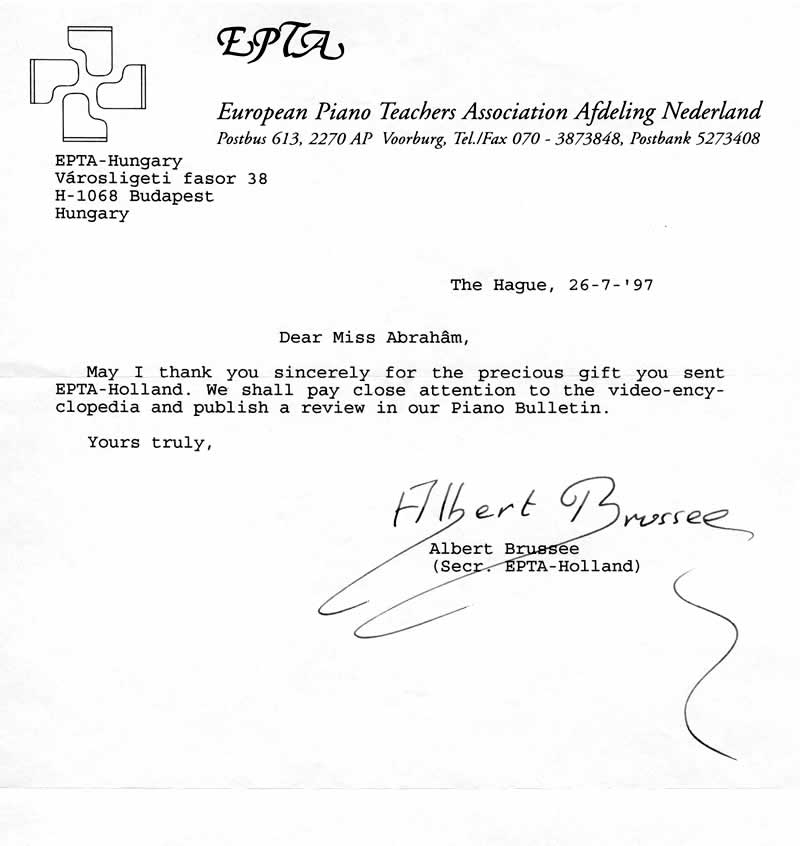 |
300 institutions in Hungary that received the videocassettes
Click on the images can be viewed in original size
__
___________________
_____
Janos Starker about Margit Varro
Postscript
MARGIT VARRO
In every person's life there are a few people with whom divergent paths cross on several occasions. An immediate kinship is sensed and a semblance of friendship develops. Only when fate and nature takes its course and one leaves the earthly domain does the other realize the sense of loss and the sorrow of not having spent more time with a unique individual. Such a person was Margit Varro. I first heard of her as a young student at the Franz Liszt Academy. Among my first pianist partners was my life long friend, Livia Rev, who left Hungary to study with Margit Varro. When she returned to Budapest the stories told about her teacher clearly defined a person in the mold of our legendary pedagogues, such as Leo Weiner and Imre Waldbauer. It was many years later, in the mid-fifties, when my profession called me to Chicago where I had the opportunity to meet Margit Varro. Then and on the few occasions we later met the first hand experiences were to ratify and strengthen the legend. The word teacher is often loosely used, especially in the arts. The confusion comes from the distinction between a coach and a teacher. Naturally one can be both, but it is not often that we find the combination in one person. A coach in music works with a student on whatever level so as to prepare a given composition for an acceptable performance. A teacher informs and guides a student to understand the "metier", to understand the language of music, to understand the "self" so as eventually the student can develop his or her own personal views on any composition. The fact that Margit Varro is not what we commonly call a household word in the world of music, is a commentary on the world, not on Margit Varro. Those on the concert stages of the world enrich the lives of millions. Margit Varro enriched and helped the lives of hundreds of pianists and continues to do so through her writings. These hundreds, in turn, continue to enrich the millions. Her knowledge, dedication and selfless giving secured her place in the musical pantheon.
Janos Starker
|
